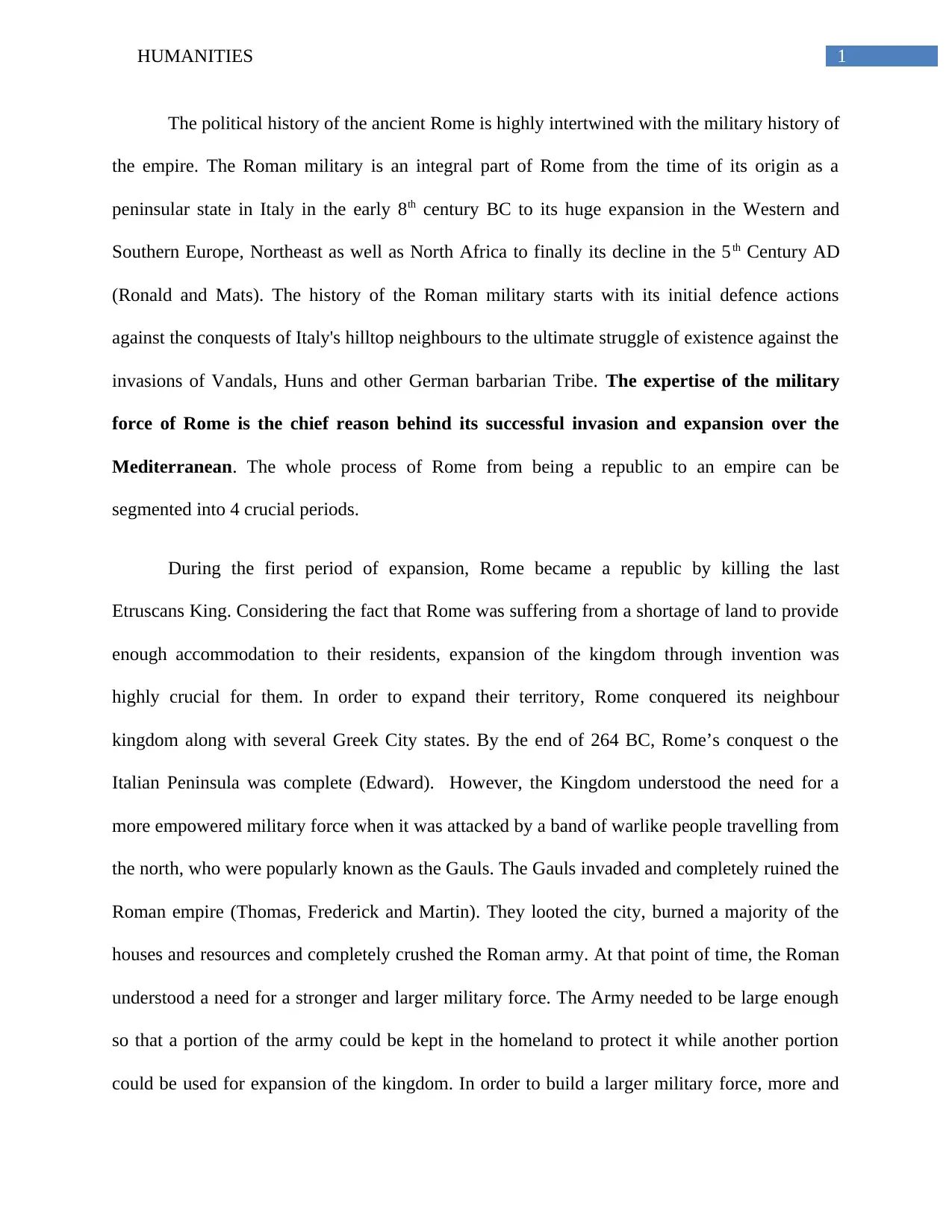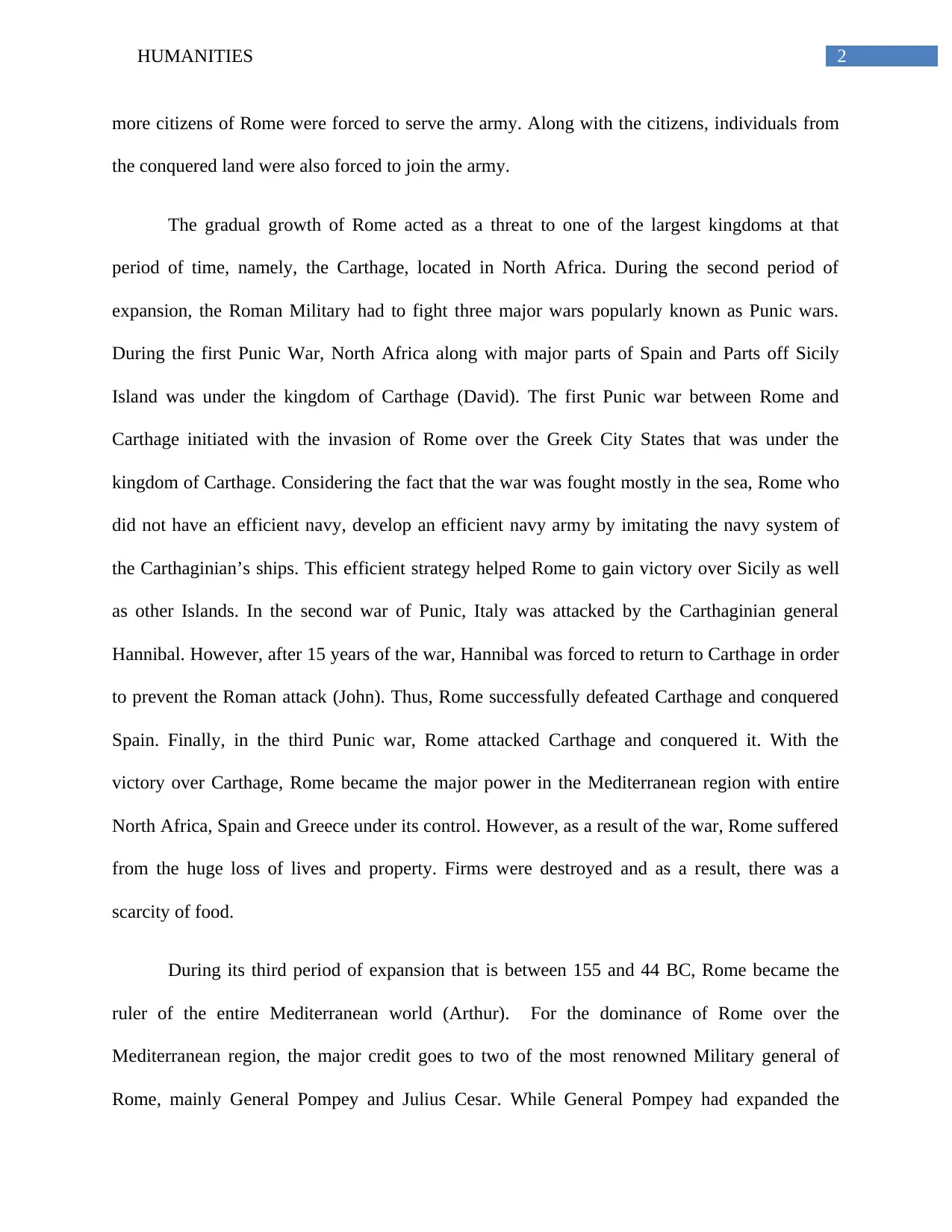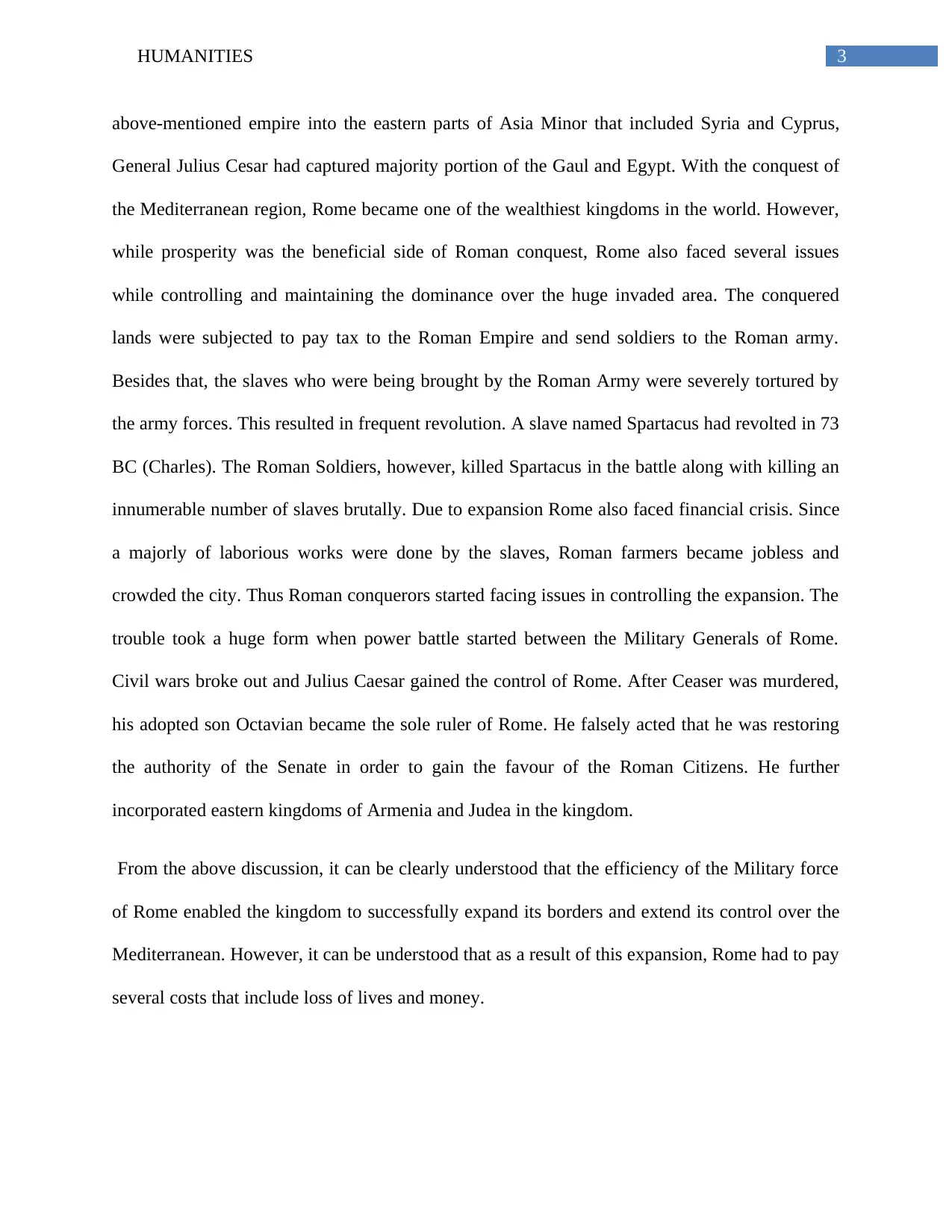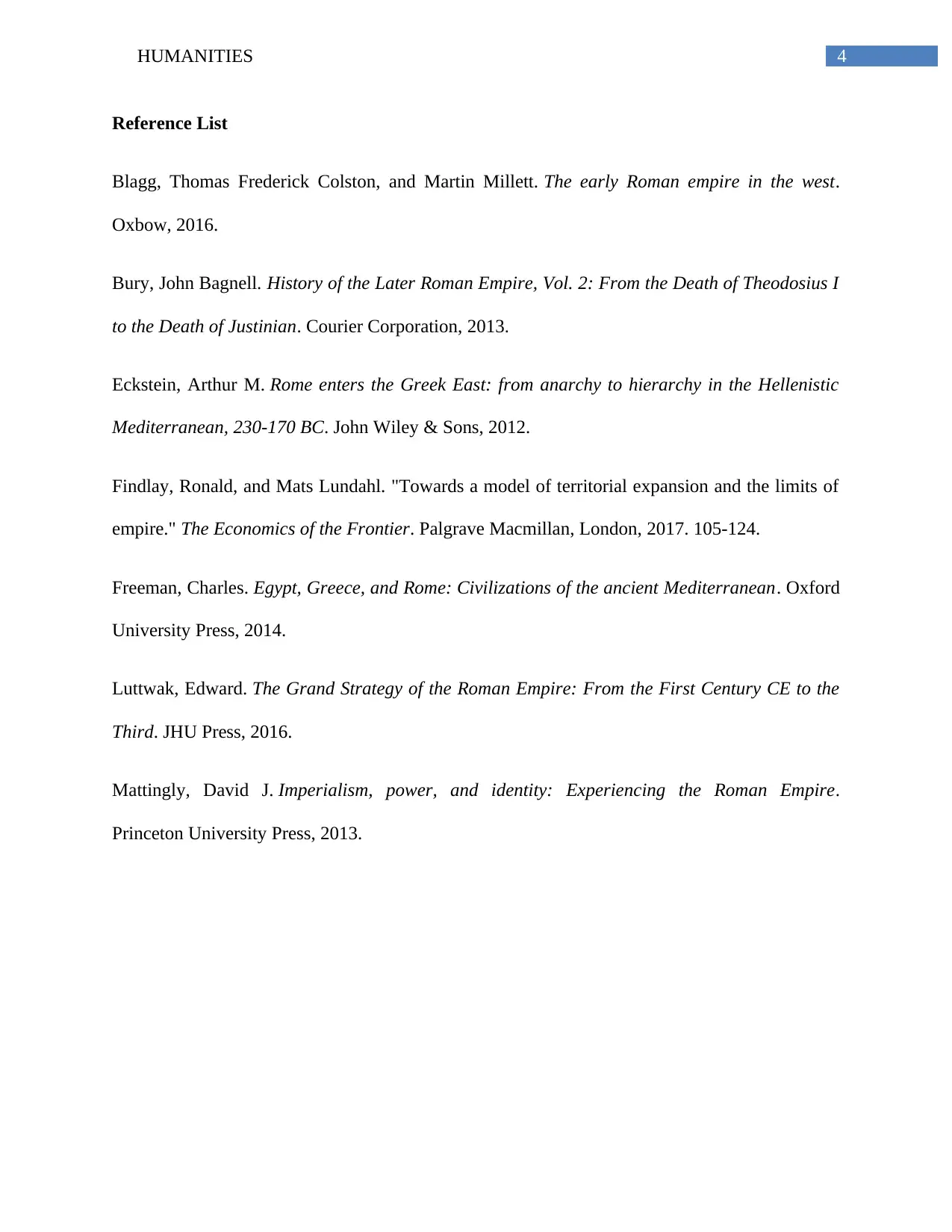Analyzing Roman Military and Political History: Expansion - HUM 100
VerifiedAdded on 2023/06/13
|5
|1337
|470
Essay
AI Summary
This essay explores the intertwined military and political history of ancient Rome, from its origins as a peninsular state to its vast expansion and eventual decline. The study identifies four crucial periods, beginning with Rome's transformation into a republic and its initial conquests of neighboring kingdoms and Greek city-states. The invasion by the Gauls highlighted the need for a stronger military, leading to the forced conscription of citizens and conquered peoples. The Punic Wars against Carthage marked the second phase, resulting in Roman dominance over the Mediterranean. The third period saw further expansion under Generals Pompey and Julius Caesar, bringing wealth but also internal issues like slave revolts and power struggles. The rise of Octavian marked a transition to empire. The essay concludes that the Roman military's efficiency was key to its expansion, but this came at a cost of lives and resources. Desklib offers more resources, including solved assignments and past papers, for students studying similar topics.

Running head: HUMANITIES
Humanities
Name of the Student
Name of the University
Author note
Humanities
Name of the Student
Name of the University
Author note
Paraphrase This Document
Need a fresh take? Get an instant paraphrase of this document with our AI Paraphraser

1HUMANITIES
The political history of the ancient Rome is highly intertwined with the military history of
the empire. The Roman military is an integral part of Rome from the time of its origin as a
peninsular state in Italy in the early 8th century BC to its huge expansion in the Western and
Southern Europe, Northeast as well as North Africa to finally its decline in the 5th Century AD
(Ronald and Mats). The history of the Roman military starts with its initial defence actions
against the conquests of Italy's hilltop neighbours to the ultimate struggle of existence against the
invasions of Vandals, Huns and other German barbarian Tribe. The expertise of the military
force of Rome is the chief reason behind its successful invasion and expansion over the
Mediterranean. The whole process of Rome from being a republic to an empire can be
segmented into 4 crucial periods.
During the first period of expansion, Rome became a republic by killing the last
Etruscans King. Considering the fact that Rome was suffering from a shortage of land to provide
enough accommodation to their residents, expansion of the kingdom through invention was
highly crucial for them. In order to expand their territory, Rome conquered its neighbour
kingdom along with several Greek City states. By the end of 264 BC, Rome’s conquest o the
Italian Peninsula was complete (Edward). However, the Kingdom understood the need for a
more empowered military force when it was attacked by a band of warlike people travelling from
the north, who were popularly known as the Gauls. The Gauls invaded and completely ruined the
Roman empire (Thomas, Frederick and Martin). They looted the city, burned a majority of the
houses and resources and completely crushed the Roman army. At that point of time, the Roman
understood a need for a stronger and larger military force. The Army needed to be large enough
so that a portion of the army could be kept in the homeland to protect it while another portion
could be used for expansion of the kingdom. In order to build a larger military force, more and
The political history of the ancient Rome is highly intertwined with the military history of
the empire. The Roman military is an integral part of Rome from the time of its origin as a
peninsular state in Italy in the early 8th century BC to its huge expansion in the Western and
Southern Europe, Northeast as well as North Africa to finally its decline in the 5th Century AD
(Ronald and Mats). The history of the Roman military starts with its initial defence actions
against the conquests of Italy's hilltop neighbours to the ultimate struggle of existence against the
invasions of Vandals, Huns and other German barbarian Tribe. The expertise of the military
force of Rome is the chief reason behind its successful invasion and expansion over the
Mediterranean. The whole process of Rome from being a republic to an empire can be
segmented into 4 crucial periods.
During the first period of expansion, Rome became a republic by killing the last
Etruscans King. Considering the fact that Rome was suffering from a shortage of land to provide
enough accommodation to their residents, expansion of the kingdom through invention was
highly crucial for them. In order to expand their territory, Rome conquered its neighbour
kingdom along with several Greek City states. By the end of 264 BC, Rome’s conquest o the
Italian Peninsula was complete (Edward). However, the Kingdom understood the need for a
more empowered military force when it was attacked by a band of warlike people travelling from
the north, who were popularly known as the Gauls. The Gauls invaded and completely ruined the
Roman empire (Thomas, Frederick and Martin). They looted the city, burned a majority of the
houses and resources and completely crushed the Roman army. At that point of time, the Roman
understood a need for a stronger and larger military force. The Army needed to be large enough
so that a portion of the army could be kept in the homeland to protect it while another portion
could be used for expansion of the kingdom. In order to build a larger military force, more and

2HUMANITIES
more citizens of Rome were forced to serve the army. Along with the citizens, individuals from
the conquered land were also forced to join the army.
The gradual growth of Rome acted as a threat to one of the largest kingdoms at that
period of time, namely, the Carthage, located in North Africa. During the second period of
expansion, the Roman Military had to fight three major wars popularly known as Punic wars.
During the first Punic War, North Africa along with major parts of Spain and Parts off Sicily
Island was under the kingdom of Carthage (David). The first Punic war between Rome and
Carthage initiated with the invasion of Rome over the Greek City States that was under the
kingdom of Carthage. Considering the fact that the war was fought mostly in the sea, Rome who
did not have an efficient navy, develop an efficient navy army by imitating the navy system of
the Carthaginian’s ships. This efficient strategy helped Rome to gain victory over Sicily as well
as other Islands. In the second war of Punic, Italy was attacked by the Carthaginian general
Hannibal. However, after 15 years of the war, Hannibal was forced to return to Carthage in order
to prevent the Roman attack (John). Thus, Rome successfully defeated Carthage and conquered
Spain. Finally, in the third Punic war, Rome attacked Carthage and conquered it. With the
victory over Carthage, Rome became the major power in the Mediterranean region with entire
North Africa, Spain and Greece under its control. However, as a result of the war, Rome suffered
from the huge loss of lives and property. Firms were destroyed and as a result, there was a
scarcity of food.
During its third period of expansion that is between 155 and 44 BC, Rome became the
ruler of the entire Mediterranean world (Arthur). For the dominance of Rome over the
Mediterranean region, the major credit goes to two of the most renowned Military general of
Rome, mainly General Pompey and Julius Cesar. While General Pompey had expanded the
more citizens of Rome were forced to serve the army. Along with the citizens, individuals from
the conquered land were also forced to join the army.
The gradual growth of Rome acted as a threat to one of the largest kingdoms at that
period of time, namely, the Carthage, located in North Africa. During the second period of
expansion, the Roman Military had to fight three major wars popularly known as Punic wars.
During the first Punic War, North Africa along with major parts of Spain and Parts off Sicily
Island was under the kingdom of Carthage (David). The first Punic war between Rome and
Carthage initiated with the invasion of Rome over the Greek City States that was under the
kingdom of Carthage. Considering the fact that the war was fought mostly in the sea, Rome who
did not have an efficient navy, develop an efficient navy army by imitating the navy system of
the Carthaginian’s ships. This efficient strategy helped Rome to gain victory over Sicily as well
as other Islands. In the second war of Punic, Italy was attacked by the Carthaginian general
Hannibal. However, after 15 years of the war, Hannibal was forced to return to Carthage in order
to prevent the Roman attack (John). Thus, Rome successfully defeated Carthage and conquered
Spain. Finally, in the third Punic war, Rome attacked Carthage and conquered it. With the
victory over Carthage, Rome became the major power in the Mediterranean region with entire
North Africa, Spain and Greece under its control. However, as a result of the war, Rome suffered
from the huge loss of lives and property. Firms were destroyed and as a result, there was a
scarcity of food.
During its third period of expansion that is between 155 and 44 BC, Rome became the
ruler of the entire Mediterranean world (Arthur). For the dominance of Rome over the
Mediterranean region, the major credit goes to two of the most renowned Military general of
Rome, mainly General Pompey and Julius Cesar. While General Pompey had expanded the
⊘ This is a preview!⊘
Do you want full access?
Subscribe today to unlock all pages.

Trusted by 1+ million students worldwide

3HUMANITIES
above-mentioned empire into the eastern parts of Asia Minor that included Syria and Cyprus,
General Julius Cesar had captured majority portion of the Gaul and Egypt. With the conquest of
the Mediterranean region, Rome became one of the wealthiest kingdoms in the world. However,
while prosperity was the beneficial side of Roman conquest, Rome also faced several issues
while controlling and maintaining the dominance over the huge invaded area. The conquered
lands were subjected to pay tax to the Roman Empire and send soldiers to the Roman army.
Besides that, the slaves who were being brought by the Roman Army were severely tortured by
the army forces. This resulted in frequent revolution. A slave named Spartacus had revolted in 73
BC (Charles). The Roman Soldiers, however, killed Spartacus in the battle along with killing an
innumerable number of slaves brutally. Due to expansion Rome also faced financial crisis. Since
a majorly of laborious works were done by the slaves, Roman farmers became jobless and
crowded the city. Thus Roman conquerors started facing issues in controlling the expansion. The
trouble took a huge form when power battle started between the Military Generals of Rome.
Civil wars broke out and Julius Caesar gained the control of Rome. After Ceaser was murdered,
his adopted son Octavian became the sole ruler of Rome. He falsely acted that he was restoring
the authority of the Senate in order to gain the favour of the Roman Citizens. He further
incorporated eastern kingdoms of Armenia and Judea in the kingdom.
From the above discussion, it can be clearly understood that the efficiency of the Military force
of Rome enabled the kingdom to successfully expand its borders and extend its control over the
Mediterranean. However, it can be understood that as a result of this expansion, Rome had to pay
several costs that include loss of lives and money.
above-mentioned empire into the eastern parts of Asia Minor that included Syria and Cyprus,
General Julius Cesar had captured majority portion of the Gaul and Egypt. With the conquest of
the Mediterranean region, Rome became one of the wealthiest kingdoms in the world. However,
while prosperity was the beneficial side of Roman conquest, Rome also faced several issues
while controlling and maintaining the dominance over the huge invaded area. The conquered
lands were subjected to pay tax to the Roman Empire and send soldiers to the Roman army.
Besides that, the slaves who were being brought by the Roman Army were severely tortured by
the army forces. This resulted in frequent revolution. A slave named Spartacus had revolted in 73
BC (Charles). The Roman Soldiers, however, killed Spartacus in the battle along with killing an
innumerable number of slaves brutally. Due to expansion Rome also faced financial crisis. Since
a majorly of laborious works were done by the slaves, Roman farmers became jobless and
crowded the city. Thus Roman conquerors started facing issues in controlling the expansion. The
trouble took a huge form when power battle started between the Military Generals of Rome.
Civil wars broke out and Julius Caesar gained the control of Rome. After Ceaser was murdered,
his adopted son Octavian became the sole ruler of Rome. He falsely acted that he was restoring
the authority of the Senate in order to gain the favour of the Roman Citizens. He further
incorporated eastern kingdoms of Armenia and Judea in the kingdom.
From the above discussion, it can be clearly understood that the efficiency of the Military force
of Rome enabled the kingdom to successfully expand its borders and extend its control over the
Mediterranean. However, it can be understood that as a result of this expansion, Rome had to pay
several costs that include loss of lives and money.
Paraphrase This Document
Need a fresh take? Get an instant paraphrase of this document with our AI Paraphraser

4HUMANITIES
Reference List
Blagg, Thomas Frederick Colston, and Martin Millett. The early Roman empire in the west.
Oxbow, 2016.
Bury, John Bagnell. History of the Later Roman Empire, Vol. 2: From the Death of Theodosius I
to the Death of Justinian. Courier Corporation, 2013.
Eckstein, Arthur M. Rome enters the Greek East: from anarchy to hierarchy in the Hellenistic
Mediterranean, 230-170 BC. John Wiley & Sons, 2012.
Findlay, Ronald, and Mats Lundahl. "Towards a model of territorial expansion and the limits of
empire." The Economics of the Frontier. Palgrave Macmillan, London, 2017. 105-124.
Freeman, Charles. Egypt, Greece, and Rome: Civilizations of the ancient Mediterranean. Oxford
University Press, 2014.
Luttwak, Edward. The Grand Strategy of the Roman Empire: From the First Century CE to the
Third. JHU Press, 2016.
Mattingly, David J. Imperialism, power, and identity: Experiencing the Roman Empire.
Princeton University Press, 2013.
Reference List
Blagg, Thomas Frederick Colston, and Martin Millett. The early Roman empire in the west.
Oxbow, 2016.
Bury, John Bagnell. History of the Later Roman Empire, Vol. 2: From the Death of Theodosius I
to the Death of Justinian. Courier Corporation, 2013.
Eckstein, Arthur M. Rome enters the Greek East: from anarchy to hierarchy in the Hellenistic
Mediterranean, 230-170 BC. John Wiley & Sons, 2012.
Findlay, Ronald, and Mats Lundahl. "Towards a model of territorial expansion and the limits of
empire." The Economics of the Frontier. Palgrave Macmillan, London, 2017. 105-124.
Freeman, Charles. Egypt, Greece, and Rome: Civilizations of the ancient Mediterranean. Oxford
University Press, 2014.
Luttwak, Edward. The Grand Strategy of the Roman Empire: From the First Century CE to the
Third. JHU Press, 2016.
Mattingly, David J. Imperialism, power, and identity: Experiencing the Roman Empire.
Princeton University Press, 2013.
1 out of 5
Related Documents
Your All-in-One AI-Powered Toolkit for Academic Success.
+13062052269
info@desklib.com
Available 24*7 on WhatsApp / Email
![[object Object]](/_next/static/media/star-bottom.7253800d.svg)
Unlock your academic potential
Copyright © 2020–2025 A2Z Services. All Rights Reserved. Developed and managed by ZUCOL.





